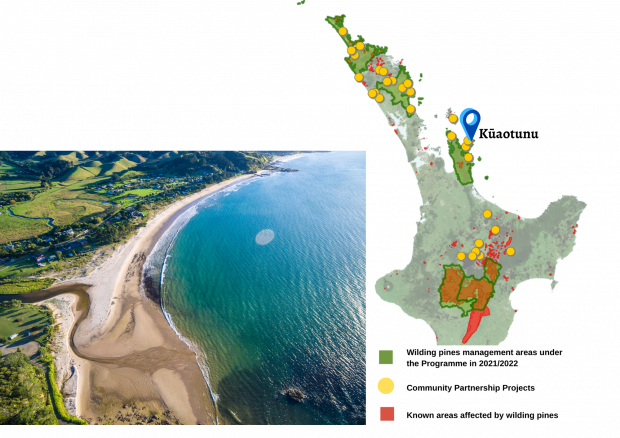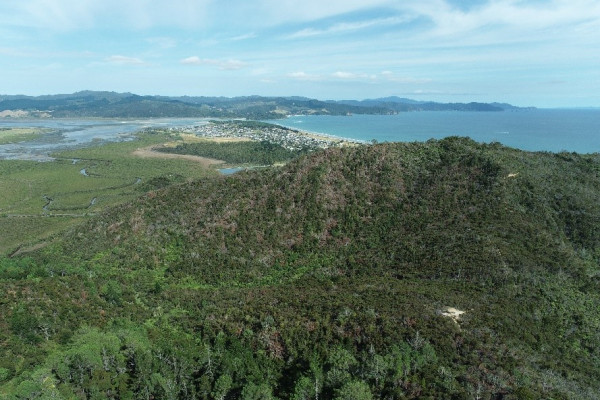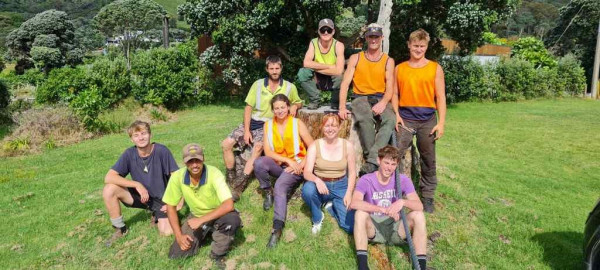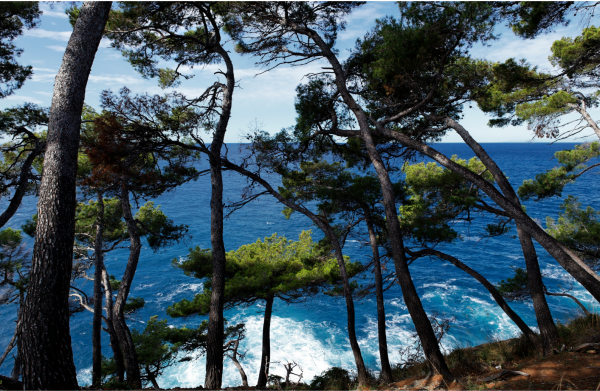 Kūaotunu Sub-peninsula
Kūaotunu Sub-peninsula
On the eastern coast of the iconic Coromandel Peninsula lies the Kūaotunu Sub-peninsula, a seaside haven stretching along the Pacific. Scattered across the area are the idyllic communities of Kūaotunu, Matarangi, Opito, Waitaia and Whauwhau. Over the years, some passionate residents have taken the lead in protecting their corner of paradise from unwanted pests and weeds by teaming up with like-minded people in their communities. Although each group has its own specialisation and focus, they all share a vision for wilding pines.
Leading the way in the mahi to remove and prevent the spread of this invasive plant are the Kūaotunu Peninsula Trust (KPT). The KPT charitable trust was founded by local landowners and biosecurity champions with a range of environmental objectives, including the control of wilding pines.
In 2020 The Trust was successful in securing community partnership funding from the National Wilding Conifer Control Program, led by Biosecurity New Zealand (BNZ), a business unit of Ministry for Primary Industries (MPI). The $375,000 BNZ fund is administered by the Waikato Regional Council in partnership with the Trust and will support the maintenance work as new pine saplings try to creep back into the area. Ngāti Hei, the local iwi supported the Trust’s initiative to bring a collective focus to the pervading wilding pine problem within the rohe.
Joe Davis, kaumatua of Ngāti Hei, says “It’s important people understand the massive threat that wilding pines and other weeds pose to the health of the environment and it is equally important that we all work together to heal the whenua.”
“The funding from the National Programme has enabled the wilding pine work to shift up a gear and raised awareness in our community of the fight against wildings.” says Kristina Pickford, a trustee of Kūaotunu Peninsula Trust.
“We saw an opportunity to work with diverse community groups who shared our vision for a wilding-free Kūaotunu sub-peninsula.”
These groups include the Rings Beach Wetland Group (RBWG), the Opito Residents and Ratepayers Group, and Project Kiwi.
In November last year, $75,000 of funding was allocated to get 34,000 wilding pines removed from 84 hectares of the Black Jack Scenic Reserve.
“The management of wilding pines has become a more prominent part of our community’s aspirations in Opito Bay. We proudly have control activities taking place on a reserve that many locals cherish and visit regularly.” says Chris Severne, Chair of the Opito Bay Ratepayers Association.
“We are an environmentally conscious community so we’re fortunate to have a large group of volunteers working on projects, from pest control to dune restoration.”
“Our strong ties with the local iwi, Ngāti Hei means we work collaboratively to ensure a sustainable future for our (Opito) Bay.”
Ridding Rings Beach of wildings
Since 2008, the Rings Beach Wetland Group (RBWG) has served as a proud kaitiaki (guardians) for the 270-hectare Matarangi Bluff Scenic Reserve. The reserve has an impressive 4.7 km walking track which meanders through regenerating native bush and wetlands.
“The initial goal was to form public walking tracks, but this quickly expanded to include predator control, planting of native flora and of course removing wilding pines and other invasive weeds.” says Dave FitzGerald, RBWG secretary.
“Up until 2021 wilding work mainly involved the felling of mature wilding pines. Now thousands of wilding pine seedlings are pulled and hand sawn weekly by our volunteers. We’re fairly efficient when it comes to conservation, while a team is putting in trap lines for predator control, they’ll bring a hand saw and clear any invasive seedlings they encounter.”
The BNZ funding in this area has supported the removal of most of the mature wildings and tens of thousands of seedlings from the reserve.
The RBGW, along with many are passionate about preserving the area’s natural biodiversity and beginning to restore the native Kauri forests and wildlife that once thrived in the area.
“We’ve worked with the Kauri 2000 Trust, helping plant around 17,000 Kauri seedlings over the last decade. Much of this planting is undertaken by tamariki from local schools. Educating our young ones about the environment is an important part of our work and how we’ll be able to keep it going for future generations” says Dave.
“The ngahere (forest) is also doing much better now after removing the initial wilding pine infestation and the on-going control of re-growth is a vital part of our maintenance plan. Not only did we uncover several species of threatened flora, but we can also confirm that the previously threatened Mātāta (Fern bird) is now breeding well too.”
Dave explains how the repeated presence of the globally endangered Matuku (Australasian Bittern) in the estuary signified the wetland's overall health.
“The Matuku rely on high quality and biologically diverse habitats for sustenance and seeing them coming back is really good sign that the biodiversity has improved significantly.”
Wilding pines have a significant impact on streams and wetlands by rapidly absorbing groundwater. In areas where there is a dense population of wilding pines, wetlands and riparian land are at risk of drying out completely.

Photo courtesy of the Rings Beach Wetland group, shows grey remnants of wilding pines controlled on Matarangi Bluff over the last few years
Protecting our National identity: The Brown Coromandel Kiwi
The Project Kiwi Trust is the oldest community-led kiwi conservation project in the world. The group has been working for over 25 years to rid the Peninsula of invasive predators like stoats and weasels which endanger New Zealand’s native bird populations.
As a collaborator on the efforts to rid Kūaotunu peninsula of wilding pines, The Project Kiwi Trust actively monitor kiwi presence in the wilding pine control areas, prior to carrying out any felling. This involves working with qualified kiwi practitioners and conservation dogs, to determine the presence and location of nesting kiwis areas. Together these Coromandel communities are keeping their growing native species safe and keeping up their ferocious mahi to remove the pests that endanger them.
The group are already seeing the removal of wilding pines resulting in higher biodiversity, better habitat and food sources for the Coromandel brown kiwi populations.
The man behind the work: “Tree Man Trav”
Travis Boyd is a seasoned arborist who honed his craft in London England and Sydney Australia before returning to his native Coromandel 15 years ago and starting his own business.
Travis’ company, Tree Man Trav Ltd., has been contracted by the Waikato Regional Council to undertake wilding pine control in Black Jack Reserve, Matarangi, Opito, Waitaia and Whauwhau.
“Being from around these parts means I can relate to some of the fears that locals might have about removing trees that have been around for a long time,” says Travis.
“Explaining the reasons behind why a certain (wilding) control method is better suited to an area than others, helps people understand how complex the control of wildings really is. And coming from someone they recognise, definitely helps!”
Last year, when the pandemic was in full swing and job opportunities were scarce, Travis was able to hire some locals to assist with hand-pulling seedlings.
“Most of my crew are local youth. I saw an opportunity to empower these impressionable young people by instilling in them confidence and good work ethics” Travis said.
“My crew have done well in developing their skills so far and many have progressed from hand pulling wildings to now being certified in tree felling. Some have also gained their climbing certification.”
“We’ll be seeing a few qualified arborists at the end of this for sure.”
Wilding pines have a devastating impact on New Zealand’s native plant species by taking away vital light and nutrients in the soil that our native vegetation needs to survive.
“We know that while we have wildings growing around these reserves, our native plants don’t stand a chance.” says Travis.
“The funding from MPI has not only benefitted the local community by providing jobs but it’s allowing us to reach our environmental goals faster.”
“It’s been really good to look back at where we started and see how far we’ve come as a community in tackling this huge problem for our country.”

Tree Man Trav crew after a hard day of pulling out pesky (wilding) pines
Coming together for the greater good
The Waikato Regional Council has several projects aimed at controlling wilding pines in the region. The work on the Kūaotunu sub-peninsula is one of the 9 community-led projects in the Waikato to receive funding from the Government’s Jobs for Nature programme, led by Ministry for Environment.
Céline Derouet lives locally and is contracted by the Waikato Regional Council as Programme Manager of the wilding pine control programme on the Kūaotunu peninsula. She is a liaison between the many key groups involved in the wildings control efforts.
“Thanks to the funding from the National Wilding Conifer Programme, ridding the Kūaotunu sub-peninsula of wilding pines has gone from being a hopeless task to a real possibility and focus for our communities.” Says Céline.
“Conservation is a long-term investment. It will take some years, but with ongoing wilding pine control, we will soon see healthier and richer landscapes for our native flora and fauna.”
“The recent wilding pine control efforts in and around Kūaotunu has shown that good collaboration between community, conservation groups, local and central government is paramount to getting on top of the wilding pine infestation – a problem that is a lot more far-reaching than one’s own backyard.”
The right tree in the right place
Pine trees, when grown in the right place, provide valuable resources to the economy like timber for housing and fibre for paper. In the wrong place windblown wildings can spread quickly and indiscriminately, providing little in the way of usable resources.
“To accomplish the vision of the right tree in the right place, New Zealanders must be aware of how urgent and damaging the growing wilding pine problem is and support action.” says Sherman Smith, National Wilding Conifer Control Programme Manager at Biosecurity New Zealand.
“The collaborative approach taken at Kūaotunu is a great example of what is needed to effectively tackle wilding pines. This is a big problem, but one that we can win with landowners, communities, industry, researchers, and local and central government all working together.”
What wilding species grow here?
The Pinus pinaster, often known as cluster or maritime pine, is the most prevalent wilding species in the Coromandel and in many other similar coastal locations. This is a hardy, fast-growing pine that is native to the Mediterranean region. They're difficult to control, and they'll grow almost anywhere – even on the side of cliffs!

Photo of Pinaster Pine jutting out from a cliffside